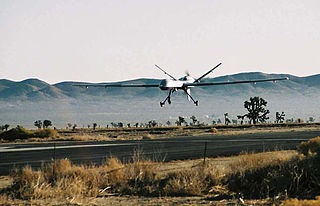
The Ethiopian occupation of Somalia, also called the Ethiopian invasion of Somalia or the Ethiopian intervention in the Somali Civil War, was a conflict largely involving Ethiopian forces and the Somali Transitional Federal Government (TFG), supplemented by troops from Puntland. The initial weeks of the conflict focused on deposing the Somali Islamist group, the Islamic Court Union (ICU), but the hardline militant group Al-Shabaab soon took center stage as an insurgency intensified in the wake of the ICU's collapse.

The African Union Mission in Somalia (AMISOM) was a regional peacekeeping mission operated by the African Union with the approval of the United Nations Security Council. It was mandated to support transitional governmental structures, implement a national security plan, train the Somali security forces, and to assist in creating a secure environment for the delivery of humanitarian aid. As part of its duties, AMISOM supported the Federal Government of Somalia's forces in their battle against Al-Shabaab militants.

The Somali Civil War (2009–present) is the ongoing phase of the Somali Civil War which is concentrated in southern and central Somalia. It began in late January 2009 with the conflict mainly between the forces of the Federal Government of Somalia assisted by African Union peacekeeping troops and al-Qaeda aligned al-Shabaab militants.

A series of battles in Hiraan, Shabeellaha Dhexe and Galgudug, between rebels of al-Shabaab and Hizbul Islam and Somali government forces and ICU militants loyal to the government, erupted during spring 2009. The fighting led to al-Shabaab capturing major government strongholds and Ethiopian forces re-entering Somalia and setting up bases in Hiraan. There was a halt in fighting during a government offensive in Mogadishu, which started on May 22.
Bulo Marer is a town in the southwestern Lower Shebelle region of Somalia. It was a base of Al-Shabaab, and was the site of an ill-fated 2013 military operation during which French commandos attempted to free a French hostage that was being held by the insurgent group. The town was taken by Somali government forces assisted by AMISOM troops after a battle on August 30, 2014. It was the site of the 2018 African Union base attack in Bulo Marer.

Ahlu Sunna Waljama'a (ASWJ) is a Somalia-based paramilitary group consisting of moderate Sufis opposed to radical Salafism. The group opposes hardline capital punishment, stonings, and limb amputations advocated by extremist interpretations of Islam, as well as laws banning music and khat. The group seeks to protect religious shrines from demolition.

This is a 2011 timeline of events in the Somali Civil War (2009–present).

Azania, officially the Republic of Azania, was a self-proclaimed autonomous state of Jubaland in southern Somalia that existed from 2011 to 2013. A group of Somali politicians proclaimed the creation of Azania on 3 April 2011 in Nairobi, with Mohamed Abdi Mohamed as its President. The state's main intentions were to contest al-Shabaab, which largely controlled Jubaland.
The Battle of Gedo is a conflict of the 2009–present phase of the Somali Civil War. Centered in the region of Gedo, it pits the Somali government and its allies against the al-Qaeda-aligned militant group Al-Shabaab.

Operation Linda Nchi had the Kenya Defence Forces enter southern Somalia beginning in 2011. The Kenyan government declared the operation completed in March 2012, but its forces then joined AMISOM in Somalia.

This is a 2012 timeline of events in the Somali Civil War (2009–present).

The Battle of Kismayo was an offensive led by the Kenya Defence Forces, under the codename Operation Sledge Hammer, to seize the port city of Kismayo, Somalia, from Al-Shabaab from 28 September 2012. Fighting alongside the Kenya Army were Raskamboni movement militia and the Somali Army.

This is a 2014 timeline of events in the Somali Civil War (2009–present).

Operation Indian Ocean was a joint military operation between the Somali military, AMISOM and the United States military against the Al-Shabaab militant group aimed at eliminating the remaining insurgent-held areas in southern Somalia. It officially began in August 2014.

This is a 2015 timeline of events in the Somali Civil War (2009–present).
This article contains a timeline of events for the Somali jihadist group al-Shabaab.
Af Urur is a village in the Puntland region of Somalia, located on the Golis Mountains, somewhat far from Bosaso, but its exact location is not known. The settlement is placed at a strategically important location, and has thus become strongly contested during the Somali Civil War. One of the most prominent clans in the village are the Tiinle.

This is a 2016 timeline of events in the Somali Civil War (2009–present).

Beginning in the late 2000s, the Federal Government of the United States has supported the Federal Government of Somalia in counterterrorism after the September 11th attacks. The Obama administration and the Trump administration increased their support of the Somali government mostly through strikes by drone and fighter aircraft, advisory missions, training, and the provision of intelligence to target the violent extremists al-Shabaab. Two U.S. special operations personnel, two contractors, one US Army soldier, and a CIA paramilitary officer have died during operations in Somalia.
In July 2022, the Islamist militant group al-Shabaab launched an invasion from Somalia into Ethiopia's Somali Region. Following attacks on the Somali side of the border, the rebel militants initially attacked Ethiopia's Afder Zone on 21 July and occupied the town of Hulhul before being driven back by Somali Region paramilitary forces. On 25 July, the militants launched a second incursion at Ferfer which was also defeated. Further cross-border attacks continued in the following days, while Ethiopia launched counter-attacks in response. Clashes between the Somali rebels and security forces inside Ethiopia extended into early August, and at least one small al-Shabaab contingent succeeded in evading the Ethiopian force and reached its main target, the Bale Mountains.












